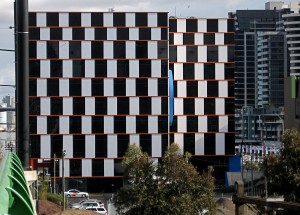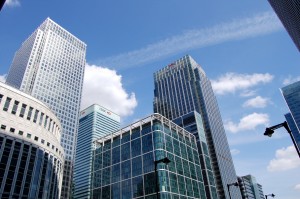Serious question, Suity. Parra seems to be going ahead in leaps and bounds in recent times. Do you really think this will end up like the Redfern housing ghettos?
Ghetto ? Of course not.
Could end up to be a soulless concrete and glass wind tunnel though.
Docklands: A graveyard of steel and glass
by
Annie Kearney
Docklands today stands as a concrete record of past mistakes.
Hailed as the new Melbourne development, Docklands is dull, soulless, bereft of people, and doesn’t have any of the cultural charm of other areas of Melbourne.
Having been described as a bit of Sydney in Melbourne, a waterfront shiny object where all the hip inner-city dwellers can have their Sunday brunch looking at the water, the area is dead outside of nine-to-five weekdays. It flies in the face of the cultural sophistication Melbournians preach to their northern neighbours.
Docklands architecture (Photo: Flickr, Rikx)
There’s nothing we can do about the weather that creates a wind tunnel down near the water, but there is something we can do about projecting life into a dead area.
Bring back the focus on getting people into cafes and restaurants.
Melbourne may not have the Opera House, Harbour Bridge or a real harbor, but it has what other Australian cities lack- it oozes charm.
Think Degraves Street, laneways tucked around Federation Square and Lygon Street.
What these streets have in their arsenal is their authentic Melbourne flavour, and the masses of people that swamp them during business hours and every weekend are a testament to that.
Described by some as a wasted heartland, a ghastly prefab ghetto of the future that was dreamed up by tasteless developers with a penchant for inner city versions of Caroline Springs. Is this the new frontier for inner city suburbs?
While shops go out of business in Docklands, the government looks towards big business and high rise buildings to fill Postcode 3008.
The state government touts the success of Etihad Stadium, which opened in 2000, ANZ, Costco, NAB, Myer and Channel 7, in Docklands as a success.
What this doesn’t show is how little life these developments bring to the area. There is no central hub and barely a food court to be seen.
It was the shining light of new development in Melbourne, but the idealised architecture of blending high-rise into waterlines has melted away as corporations have taken over.
Thirteen years on from its creation, Docklands continues to divide Melbourne.
What if we, as a community could convince the Melbourne City Council and Places Victoria, who share responsibility over the area, that what Docklands needs is not another corporate company relocating, but rather a focus on getting mums and dads and their kids down to Docklands on a Saturday or Sunday.
Docklands high-rise buildings (Flickr, Rikz)
The state government’s plan to create new community facilities is a step in the right direction.
The western end of windswept Docklands will get a
makeover, with work expected to start on an $18 million development early 2014.
With plans for two soccer pitches, children’s playground and exercise circuit, it’s the kick-start the area so desperately needs.
Docklands must lose its title of a windswept no-man’s land.
Just please don’t mention the Observation Wheel.
http://thecityjournal.net/news/docklands-a-graveyard-of-steel-and-glass/








